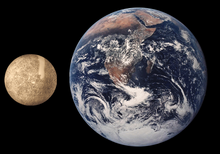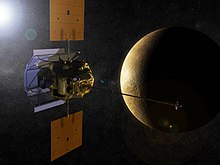Wikijunior:Solar System/Mercury

What is Mercury?[edit | edit source]
Mercury is the closest planet to the Sun. It is a terrestrial planet; that means a planet made from rock like Earth. It does not have a gas atmosphere, so there is no weather. For a long time, only one spacecraft, Mariner 10, had visited Mercury. In January 2008, the MESSENGER spacecraft went by Mercury. It has gone by Mercury two more times, and has started to go around the planet in 2011.
How big is Mercury?[edit | edit source]

Mercury is 4879 km across. Mercury's diameter is just less than half the diameter of the Earth. It is the smallest planet in the Solar System. Only dwarf planets like Pluto are smaller. Because Mercury is much closer to the Sun than the Earth, it can only be seen just after the sun goes down at night or shortly before it rises in the morning.
What is Mercury's surface like?[edit | edit source]

Mercury has craters like those on the Earth's moon. The largest crater on Mercury is the Caloris Basin. It is about 1300 km wide. It was created by a huge asteroid hitting Mercury. The asteroid was probably 100 km wide, but it hit Mercury's surface so hard that it made a much bigger hole.
| The Solar System |
|
Introduction |
The surface also has big cliffs called scarps. They were made long ago when Mercury cooled down. It shrank, causing the surface to get wrinkled in some places. This wrinkling created the scarps.
There may also be ice on the top and bottom of Mercury. Like the Earth, these areas (called poles) don't get much warmth from the Sun. Any ice there won't melt.
It is very hot during the day (over 400°C) because Mercury is so close to the Sun. At night it is very cold because Mercury loses almost all its heat since there is almost no atmosphere to keep the warmth there. The temperature can fall to almost -175°C.
How long is a day on this planet?[edit | edit source]
Mercury rotates (spins around) much more slowly than the Earth. It takes Mercury 58 days to spin once as viewed from a distant star. Because Mercury orbits the sun very quickly, a day on Mercury lasts longer than 58 days. If you were standing on Mercury at the equator and timed how long it took the sun to go from directly overhead to sunset to sunrise and then rise directly overhead again, it would take 176 Earth days. These long days and nights allow for the temperatures to rise as high, and fall as low, as they do.
How long is a year on Mercury?[edit | edit source]

Mercury has the shortest year in the Solar System. It is about 88 Earth days long.
It used to be believed that the same side of Mercury always faced the Sun. In order for this to be true, Mercury would have to take the same amount of time to rotate (spin around) as it does to circle the sun. From watching it carefully we now know that Mercury's rotation is somewhat faster than its orbit. Because of the way the orbit and rotation work together, on Mercury, a day (the time from one sunrise to the next) is actually almost twice as long as a year.
What is Mercury made of?[edit | edit source]
The center of Mercury is made of iron in partly-molten (liquid) form. We know that there is iron at the center because the planet generates a magnetic field. It contains more iron for its size than any other planet in the Solar System. The rest of Mercury, its thick crust, is made of a special type of rock called silicate rocks. There are craters near the poles that are constantly in shadow. Some of these craters contain ice. There is a huge crater on Mercury called Caloris Basin. It was formed when a comet hit the planet and lava or molten rock filled the impact crater. The round wall of this crater is over 2km tall.
How much would Mercury's gravity pull on me?[edit | edit source]
If you were on Mercury, it would pull you down less than half (38%)as much as the Earth. An item that weighs 100 pounds on Earth, would only weigh 38 pounds on Mercury.
Who discovered Mercury?[edit | edit source]

Nobody really knows who first discovered Mercury, but the first known recorded observations of it are from tablets in Assyria about three and a half thousand years ago, in the 14th century BCE. This was probably something like an informational article about Mercury's movements. In these tablets, Mercury is called (in translation) The Jumping Planet. Almost every ancient civilisation had their own written records and names for Mercury.
In 1639, an Italian astronomer named Giovanni Zupi observed that Mercury has phases, like the phases of the Moon, as it orbits around the Sun. This is evidence that it does orbit around the Sun, an idea that was fairly new at the time, suggested less than a hundred century earlier by Copernicus.
Before the twentieth century, it was a mystery to all the astronomers how long it took for Mercury to rotate. They solved this mystery in 1962, when some astronomers sent radar signals to Mercury, which then bounced back to Earth: it takes 59 days for Mercury to rotate.
It isn't easy to sent a space probe from Earth to Mercury, because Mercury is much closer to the Sun and therefore orbits the Sun much faster than Earth does. So a space probe would have to burn a lot of fuel to match its speed with Mercury, in order to orbit—or land on—the planet. In 1973, a space probe Mariner 10 was sent to take measurements of Mercury and map its surface. Because orbiting Mercury would be so expensive, Mariner 10 orbited the sun instead, and would take pictures each time it got close enough to Mercury. Unfortunately, when Mariner 10 finally ran out of fuel, it had only mapped about 45% of the surface. However, it also discovered that Mercury has an iron-rich core and a magnetic field. 29 years later, in 2004, another probe was launched, named MESSENGER. MESSENGER stands for MErcury Surface, Space ENvironment, GEochemistry, and Ranging. MESSENGER followed a complicated path that would slowly match speeds with Mercury without using much fuel. It passed by Mercury three times, and finally settled into orbit around Mercury more than six years after it was launched. By March 2013, MESSENGER had mapped 100% of the surface of Mercury.
Who is this planet named after?[edit | edit source]

In Roman mythology, Mercury (Latin Mercurius) was the messenger of the gods. He wore a hat and sandals with wings on them, allowing him to travel around the world very quickly. The planet Mercury was named after him because it moves faster than any other planet in the Solar System. It moves nearly 48 km every second! (Of course, the Romans didn't know that, but they could see how fast it moved across the sky.)The Greeks called this god Hermes.
References[edit | edit source]
NASA's Solar System Exploration[1]
Arnett, Bill. The Nine Planets[2]
Worldbook Online [3]
Worldbook@NASA, "Mercury"[4]
NASA Planetary Fact Sheet [5]
Hamilton, Calvin J. . Solarviews.com, "Mercury" [6]
Encyclopedia Mythica, "Mercury" [7]
Col, Jeananda. Enchanted Learning/Zoom Astronomy [8] 1998-2005
Usborne Internet-Linked Science Encyclopedia, Usborne Publishing Ltd. ISBN 0794503314[9]
Dickinson, Terrence. The Universe and Beyond . Firefly Books ISBN 1552093611
